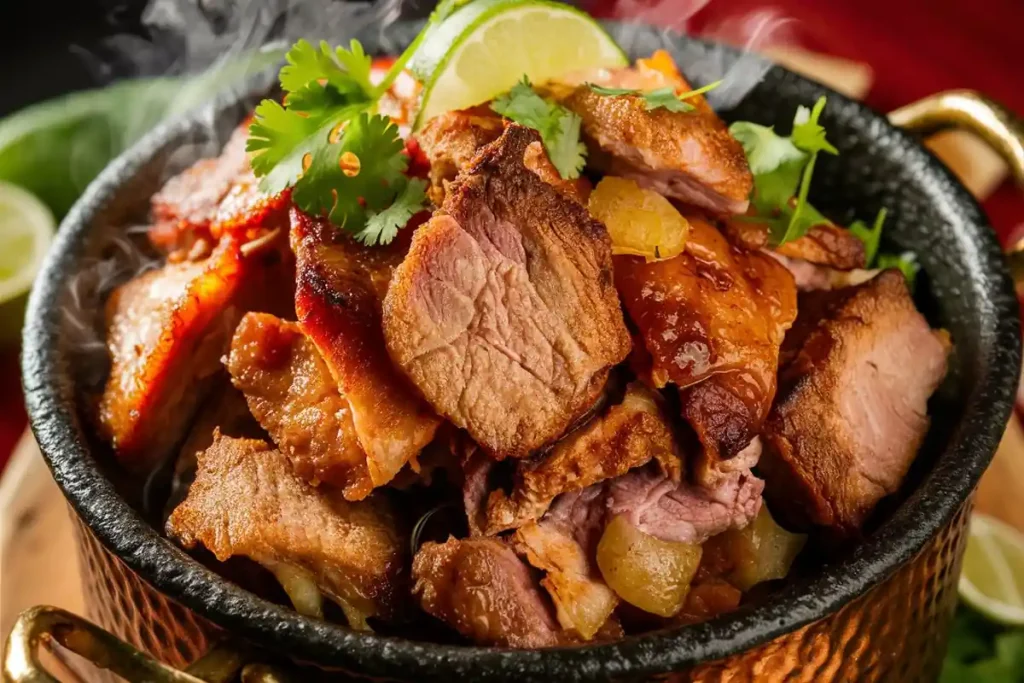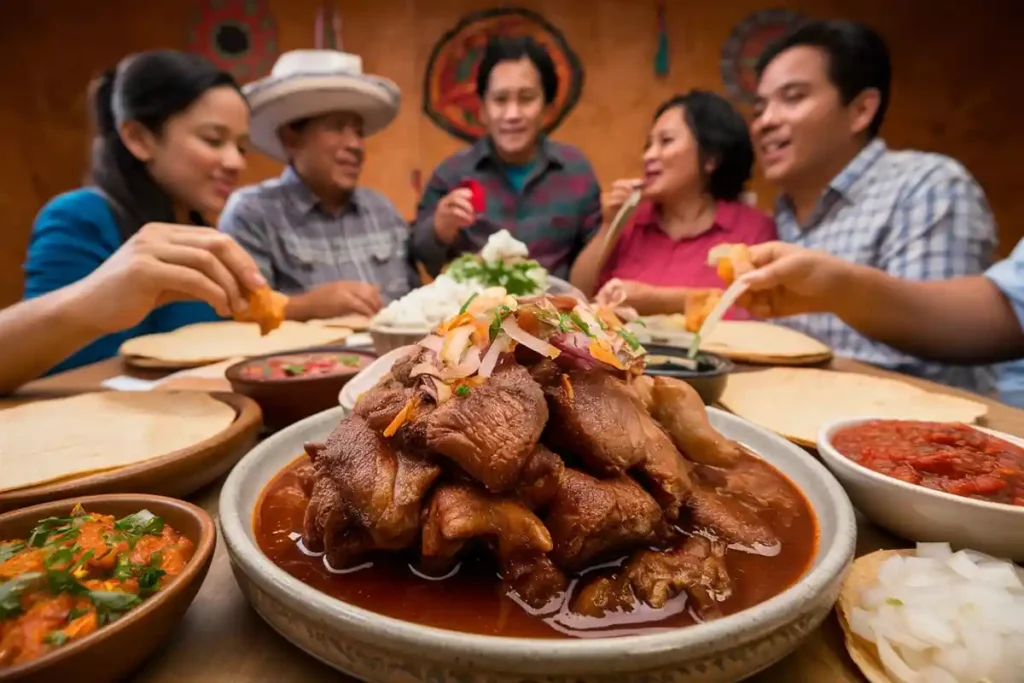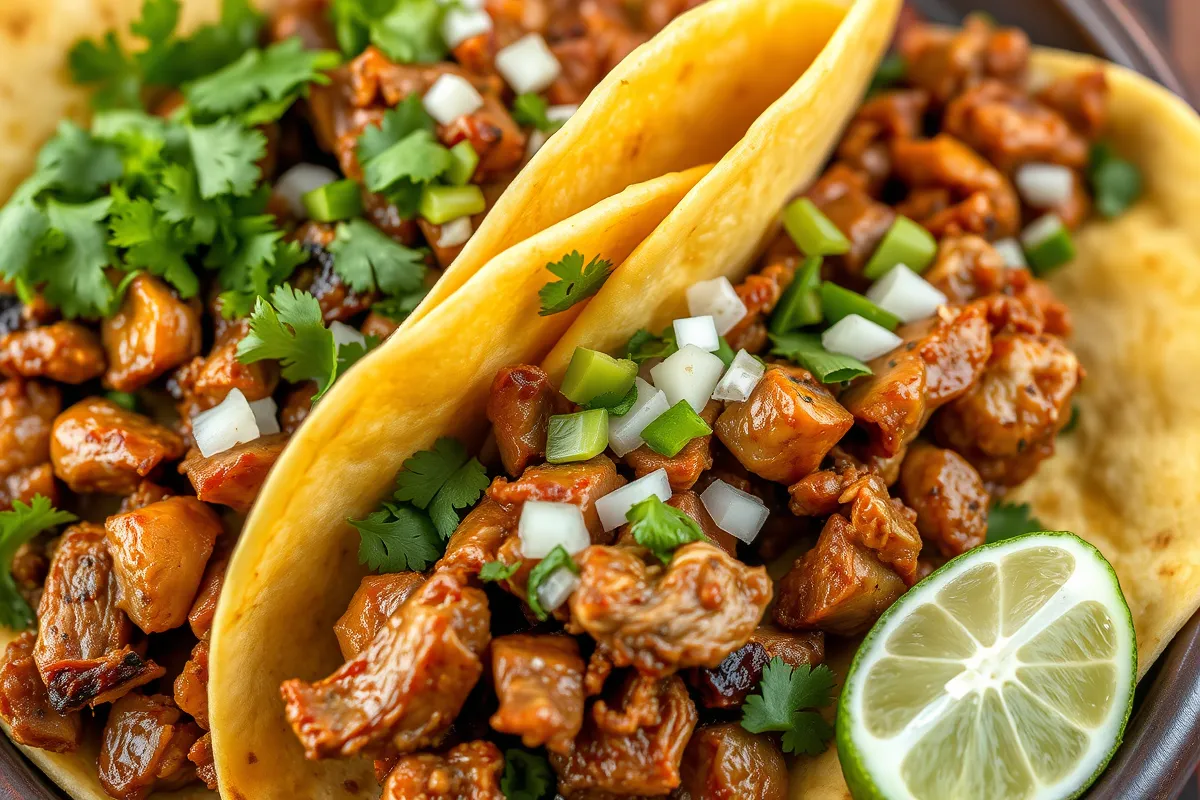Table of Contents
Carnitas, a traditional Mexican dish, represents a perfect harmony of flavors, textures, and techniques. In this comprehensive guide, we will explore how do Mexicans eat carnitas, tracing the origins of this beloved dish, traditional accompaniments, and cultural practices that make it an iconic part of Mexican cuisine. Whether you’ve tasted carnitas before or are new to this culinary delight, this guide will provide you with everything you need to know about how do Mexicans eat carnitas and the best ways to enjoy this flavorful dish.
What Are Carnitas?

Carnitas, which translates to “little meats” in Spanish, is a dish that consists of pork, slow-cooked until tender and juicy, then crisped to perfection. The preparation involves slow-braising the pork in its own fat—a method known as confitar—creating a beautifully soft texture on the inside with a slightly crisp exterior. How do Mexicans eat carnitas? The result is a mouthwatering, flavorful meat that pairs well with various accompaniments, making it a staple in many traditional Mexican dishes.
Mexicans eat carnitas in many ways, but the most common approach is to serve them in tacos, with a range of toppings and salsas that enhance the flavor of the tender protein. However, the versatility of carnitas extends well beyond tacos, as many people across Mexico enjoy them in a variety of traditional dishes.
For more information on the history and significance of carnitas, as well as an in-depth look at traditional Mexican cooking techniques, check out our detailed recipe and guide on how do Mexicans eat carnitas and how to prepare this beloved dish.
How Do Mexicans Eat Carnitas?
How do Mexicans eat carnitas? Typically, carnitas are served alongside warm, freshly made corn tortillas, which serve as a perfect vessel to hold the juicy, flavorful meat. The dish is usually accompanied by a selection of fresh garnishes, such as chopped onions, cilantro, lime wedges, and various salsas. These toppings not only add layers of texture but also balance the richness of the pork with acidity and freshness, making how do Mexicans eat carnitas a delightful and well-rounded experience.
Below are the common accompaniments that Mexicans use to enjoy carnitas:
- Corn tortillas: Soft, warm corn tortillas are the most popular way to enjoy carnitas, allowing the flavors to shine without overwhelming the dish.
- Pico de gallo: A fresh salsa made with tomatoes, onions, cilantro, and lime juice.
- Sliced avocado: Creamy avocado adds richness to balance out the flavors.
- Radishes: Sliced radishes provide a crisp texture and a slightly peppery flavor that contrasts well with the fatty pork.
- Pickled jalapeños: Adding a bit of heat, pickled jalapeños offer a spicy and tangy contrast.
Traditional Methods of How Mexicans Eat Carnitas
When considering how do Mexicans eat carnitas, it is crucial to appreciate the cultural and regional influences that shape the dish. Carnitas originated in the state of Michoacán, which remains famous for its unique preparation methods. Traditionally, cooks prepare the pork in a large copper pot, which distributes heat evenly and ensures each piece of meat cooks perfectly. Today, carnitas enjoy popularity across Mexico, with each region offering unique variations on how do Mexicans eat carnitas and how they are served.
How do Mexicans eat carnitas? Mexicans often enjoy carnitas as a communal dish—it is common to see families and friends gather around a large serving of carnitas, with a variety of tortillas, salsas, and garnishes set out so everyone can assemble their tacos to their liking. This practice embodies the spirit of sharing and hospitality, which is a significant aspect of Mexican culture and a key part of how Mexicans eat carnitas.
For an authentic Mexican carnitas experience, it is important to eat them fresh, ideally right after cooking when the meat is still warm, tender, and crispy.
Different Dishes Using Carnitas
While carnitas tacos are the most popular way to enjoy this dish, there are many other delicious Mexican dishes that feature carnitas. Here are some common variations:
- Carnitas Burrito: A flour tortilla filled with carnitas, beans, rice, cheese, and guacamole. This is a popular choice in northern Mexico and the southwestern United States.
- Tostadas de Carnitas: Crispy tostadas topped with carnitas, shredded lettuce, crema, and salsa.
- Carnitas Quesadilla: A large flour tortilla filled with melted cheese and carnitas, cooked until the tortilla is golden and crispy.
- Carnitas Tamales: Carnitas can be used as a filling for tamales, giving them a rich, savory flavor.
- Torta de Carnitas: A Mexican sandwich that features carnitas, refried beans, pickled jalapeños, and avocado, all served on a crusty roll.
Why Do Mexicans Eat Carnitas?

How do Mexicans eat carnitas? The love for carnitas is deeply rooted in Mexican culinary culture. The process of cooking carnitas—slowly braising pork until it is tender—allows the flavors to develop fully, resulting in a dish that is incredibly satisfying. It is a food that brings people together, often served at special occasions, such as family gatherings, fiestas, and even holidays. The cooking process, the sharing, and the enjoyment of carnitas all contribute to its place in Mexican hearts and explain how Mexicans eat carnitas.
How do Mexicans eat carnitas? The dish represents more than just food; it is a symbol of celebration and community. People often make carnitas in large quantities, making them ideal for gatherings where sharing food is central to the occasion. The preparation and serving of carnitas highlight the importance of hospitality in Mexican culture and are key elements of how Mexicans eat carnitas.
How Do Mexicans Eat Pork?
Pork plays an important role in many Mexican dishes, and regional preferences and traditional recipes influence how Mexicans prepare and enjoy it. Beyond carnitas, Mexicans savor pork in a variety of forms across the country.
- Cochinita Pibil: A Yucatán specialty, where cooks marinate pork in achiote paste and sour orange juice, then slow-cook it in banana leaves.
- Chicharrón: Fried pork rinds that are crunchy and often used as a topping for tacos or eaten on their own with hot sauce.
- Al Pastor: Thinly sliced pork, marinated in a mixture of spices and pineapple juice, then cooked on a vertical spit.
Each of these dishes showcases the versatility of pork in Mexican cuisine, with different cooking techniques, marinades, and seasonings that bring out distinct flavors.
Are Carnitas Usually Fried?
How do Mexicans eat carnitas? Are carnitas usually fried? Technically, people don’t fry carnitas in the traditional sense. Instead, cooks slow-cook the meat in its own fat, using a technique called confit. This method differs from deep-frying. They cook the meat at a lower temperature over a longer period, which makes it tender and juicy. At the end, they increase the heat to crisp the exterior, creating the characteristic crispy and tender texture of carnitas, and explaining how Mexicans eat carnitas.
Variations in Carnitas Across Mexico
People consider Michoacán the birthplace of carnitas, but other regions across Mexico have put their own unique spin on this beloved dish. Understanding the different variations will give you deeper insight into how do Mexicans eat carnitas and the diverse ways the dish has evolved:
- In Guanajuato, cooks typically season carnitas with a mixture of herbs and spices that include bay leaves, thyme, and marjoram. This gives the pork a distinctive herbal flavor that differentiates it from the classic Michoacán version.
- Jalisco-Style Carnitas: Carnitas in Jalisco are often served with a side of frijoles charros (cowboy beans) and spicy salsa. Cooks prepare the meat in a similar way to the Michoacán style but season it slightly differently to give it a more robust flavor.
- In Puebla, cooks sometimes make carnitas with a sweeter touch by adding orange juice or pineapple during the cooking process. This adds a subtle sweetness that balances the rich, savory pork.
These regional differences highlight the creativity and adaptability of Mexican cuisine. Each region brings its local flavors and traditions to the dish, resulting in a variety of carnitas that still maintain the essential characteristics of tender, juicy pork.
The Significance of Carnitas in Mexican Celebrations
How do Mexicans eat carnitas? Carnitas play a significant role in many Mexican celebrations and gatherings. Special events such as weddings, birthdays, and holidays like Día de los Muertos and Las Posadas often have them prepared. The act of preparing carnitas is a communal experience, where family members and friends gather to cook, share stories, and enjoy each other’s company, showcasing how Mexicans eat carnitas in a social and meaningful way.
How do Mexicans eat carnitas? In many Mexican towns, weekends are synonymous with carnitas. Families visit their local carnicería (butcher shop) to buy freshly made carnitas. These weekends are filled with laughter, music, and delicious food. Entire neighborhoods often come together, with everyone contributing a dish or drink to accompany the carnitas. This communal approach to food embodies the spirit of Mexican culture—warmth, hospitality, and togetherness, highlighting how Mexicans eat carnitas in a shared and celebratory way.
Popular Sides and Accompaniments for Carnitas
Aside from the traditional garnishes, many people pair carnitas with a variety of sides to complete the meal. Some popular accompaniments include:
- Frijoles Charros: These are pinto beans cooked with bacon, chorizo, onions, tomatoes, and chili peppers. Moreover, frijoles charros are hearty and full of flavor, making them the perfect side dish to complement the rich carnitas.
- Nopalitos: Sliced cactus paddles, often cooked with tomatoes, onions, and cilantro. Nopalitos add a unique texture and slightly tangy flavor that pairs well with the richness of carnitas.
- Mexican Rice: Fluffy, seasoned rice that serves as a mild side to balance out the bold flavors of carnitas and salsas.
- Guacamole: Freshly made guacamole adds a creamy, rich element that balances the texture and flavor of the crispy carnitas.
- Elote: Mexican street corn, typically grilled and coated with mayonnaise, cheese, chili powder, and lime juice. The sweetness of the corn and the tangy toppings provide an excellent contrast to the savory carnitas.
How to Make Authentic Carnitas at Home
To experience how Mexicans eat carnitas at home, making carnitas is simpler than you might think. The traditional preparation involves a large copper pot and open flame, but you can recreate the flavors in your kitchen with a few adjustments.
Ingredients
- 4 pounds of pork shoulder (or pork butt), cut into large chunks
- 1 cup of lard (or vegetable oil)
- 1 onion, quartered
- 6 cloves of garlic
- 1 tablespoon of salt
- 1 tablespoon of black pepper
- 1 tablespoon of oregano
- 1 teaspoon of cumin
- 1 orange, juiced
- 1 bay leaf
Instructions
- Prepare the Pork: Season the pork chunks with salt, pepper, oregano, and cumin. Make sure the seasoning is evenly distributed.
- Heat the Lard: In a large, heavy-bottomed pot, heat the lard over medium heat until it melts and becomes hot. Add the onion, garlic, and bay leaf.
- Cook the Pork: Add the seasoned pork to the pot and cook for about 1.5 to 2 hours, stirring occasionally. Make sure the heat remains low so that the pork cooks slowly and becomes tender.
- Add Orange Juice: After about an hour of cooking, add the juice of one orange to the pot. Then, continue cooking until the pork is tender and can be easily pulled apart with a fork.
- Crisp the Pork: Once the pork is tender, increase the heat slightly and cook until the edges of the pork become crispy. Stir frequently to prevent burning.
- Serve: Remove the pork from the pot and let it rest for a few minutes. Shred the meat and serve it with warm corn tortillas, fresh salsa, and your favorite garnishes.
Health Considerations When Eating Carnitas
Carnitas are undeniably delicious; however, they are also rich due to the slow-cooking process in fat. Therefore, if you’re considering the health aspects of how Mexicans eat carnitas, here are some tips to enjoy them in a balanced way:
- Portion Control: Carnitas are typically rich and high in fat, so it’s important to enjoy them in moderation. Pair them with plenty of fresh vegetables to create a balanced meal.
- Healthy Garnishes: Choose healthier garnishes such as pico de gallo, fresh cilantro, and radishes to add freshness without extra calories.
- Alternative Cooking Methods: For a lighter version of carnitas, use a slow cooker to prepare the pork without added lard. It won’t be as crispy, but it will still be tender and flavorful.
Carnitas and Their Influence on Mexican Street Food
Carnitas have also played a significant role in shaping Mexican street food culture. Walk through any bustling Mexican market, and you’re likely to come across a vendor selling freshly made carnitas. These vendors often cook the pork on-site, filling the air with the savory aroma of seasoned meat.
Street vendors serve carnitas in a variety of ways, including:
- Tacos: The most popular street food, carnitas tacos are simple yet packed with flavor. In addition, street vendors often serve these tacos with just a sprinkle of onions, cilantro, and a squeeze of lime.
- Gorditas: A type of thick tortilla that is split open and filled with carnitas, cheese, and salsa. Additionally, gorditas are hearty and perfect for a quick, satisfying meal.orditas are hearty and perfect for a quick, satisfying meal.
- Sopes: Thick, fried masa cakes topped with carnitas, refried beans, lettuce, cheese, and crema. Sopes provide a perfect base for the tender pork.
Mexican street food is known for its vibrant flavors and diversity. Carnitas are a staple that has significantly contributed to this rich culinary landscape.
Conclusion
Carnitas are a key part of Mexican cuisine, embodying culture and celebration. From slow-cooked pork to sharing tacos with loved ones, they capture the warmth and joy of Mexican gatherings. Whether enjoyed at a street market or made at home, carnitas offer a taste of Mexico’s rich culinary heritage. Gather your friends and family, and savor the magic!
FAQ
What exactly are carnitas?
A: Carnitas are a traditional Mexican dish consisting of pork that’s slow-cooked in its own fat until tender and juicy, then often crisped on the outside.
How are carnitas traditionally served?
A: The most common way is in tacos with warm corn tortillas, topped with fresh garnishes like chopped onions, cilantro, lime wedges, and various salsas.
What’s the difference between carnitas and pulled pork?
A: While both involve slow-cooking pork until tender, carnitas are traditionally cooked in lard (its own fat) using a confit method, resulting in a richer flavor and crispier exterior. Pulled pork often uses different seasonings and is cooked in a smoker or oven.
Are carnitas healthy?
A: Carnitas are rich due to the cooking method. Enjoy them in moderation, pair them with healthy garnishes, and consider alternative cooking methods (like a slow cooker) to reduce the fat content.

